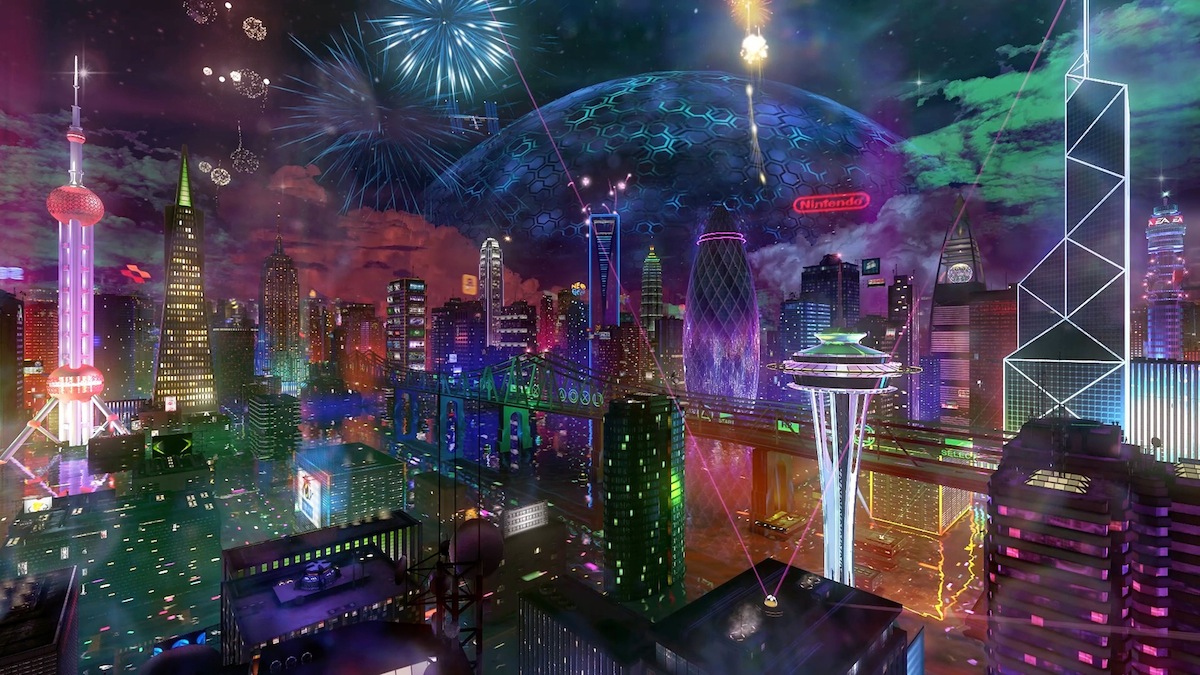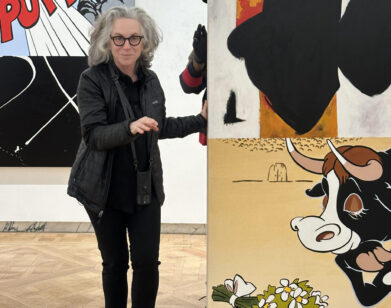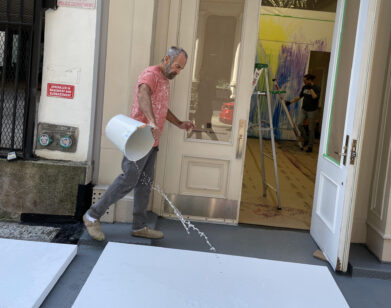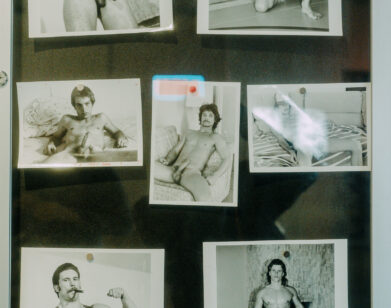Tabor Robak’s Virtual Dreamscapes

ABOVE: A DETAIL FROM TABOR ROBAK’S 20XX, COURTESY OF THE ARTIST AND TEAM GALLERY
Tabor Robak’s computer-generated images render aesthetic spaces through multi-screened videos, unifying both a critical reflection on technological fakeries and the seductive commerciality of virtual worlds. Every decision made in Robak’s world—both physical and virtual—is partially just because it’s indulgent; but it is also essentially aware of the problematic nature of this indulgent culture. He makes you aware of the loneliness technology can create in a person, the isolation a gamer might experience in pursuing the idealistic spaces of these video game worlds. His emphasis is on the effect—the look—of the environments he creates in his work, the incandescent purples and reds that appear in a cityscape’s sky, or a mesmerizing game-like display that scrolls through pages and pages of bright, sparkling icons. As a former graphic designer for brands like AT&T, T-Mobile, and Nike, Robak understands consumer marketing from the inside. His art uses the same skill sets and aesthetics he used when designing advertisements, but says he likes to “[disrupt] it in a way that you can’t do when you actually have to sell a product.”
Robak’s studio is basically a desk with four monitors set up in an upside-down triangle. This is where he has sat every day for months preparing for his first solo show opening this Sunday at Team Gallery. The four video pieces—20xx, Xenix, Free-to-Play, and Algos—will be mounted on the gallery walls like paintings, spread over 14 monitors, Robak says. He wants to avoid the captive feeling that videos can sometimes induce when you’re in a dark room and have entered halfway through. What he does hope for is that viewers will reflect on his work and the dichotomies between the interiors and exteriors of their own personal worlds in relation to technology.
We recently spoke to Robak in his studio and experienced the virtual environments he has created for the exhibition.
MOLLY ELIZALDE: You’ve explained your aesthetic as “Photoshop tutorial aesthetic.” What does that mean?
TABOR ROBAK: A Photoshop tutorial is not really about the application of the technique—it’s all about the effect. So in my work I really like to draw attention to the effects, because they are, typically, the most superficial elements of things. People love to hate on J.J. Abrams for his lens flares or Michael Bay for the explosions, and I see those things as total sprinkles on a cake—just meaningless. But I like to make that the content, so it’s a chance to think about what those mean.
ELIZALDE: Right. So it’s superficial, but at the same time it’s the main content of your work. How do you grapple with that?
ROBAK: Yeah. Well, I think there’s a little bit of a risk there because a viewer who’s maybe not going to be as receptive may just see it as self-indulgence, which it is to a degree; but I’m very critical about the aesthetics I use. I get to it by going the complete opposite way.
ELIZALDE: Can you talk more about being critical about it? Because there’s a way that you can look at your work as a critique of commercial culture. You’re being critical of its superficiality and that being at the center of your work, but it can also be completely indulgent. So how are they working together?
ROBAK: Well I think the way that we interact with a lot of things in the world is: I know I shouldn’t love this thing, but I do. I know I shouldn’t eat this candy bar, but I’m going to. I know I shouldn’t watch these stupid programs and let them influence my opinion of the way people should be, but I do. And so here—this piece [Xenix] is all about how much I love guns and how they’re depicted in media and this whole connoisseurship that goes along with them. Here it shows the modeling of these four different fantasy weapons; I’ve tried to find a range of tonalities amongst them. For example, this pipe bomb here is made out of these very familiar household objects, and it captures the true horror of violence. Whereas, this laser rifle is completely neutered in its implied violence. It looks like sci-fi; you imagine it shoots a purple laser—you can’t really imagine that killing someone. I’m using this design language inspired by the projected future vision videos created by Microsoft and Apple. Something that’s common in these videos is they have to fill up with a story of a family using these devices and these stories just paint such a banal portrait of family life: picking up the dog, and doing errands, and all these tasks.
ELIZALDE: What is the fridge doing in this piece?
ROBAK: This is spanning seven monitors, so you can imagine this fridge breaks through the divides in the monitors. So now it’s continuing the story of preparing for a bake sale and doing these silly things. And then we come into the fridge and the fridge laser analyzes the ingredients we need for a bake sale. But also, the way this is stylistically presented it’s this [sings] ah moment, and it’s communicating a feeling about technology. So this piece goes through four different operating systems. The first one is very based on Adobe and real-world computers, and it’s very militaristic and it upgrades itself into a new operating system that’s inspired by smart phones and tablet devices. And then I get into the view where everything is projected on glass in the world. And then the whole thing is launched into space and goes into sci-fi nonsense, like a kids’ Transformers movie.
ELIZALDE: How did you get to this idea of the family from this very militaristic image that you have here?
ROBAK: There’s this implied violence throughout the whole piece, and I wanted to bring that to a more human level. This brings something horrible to mind, like a house blowing up, but it also brings something totally harmless to mind, like a kid playing Call of Duty in the upstairs bedroom. I think, for me, the way to address something is by pointing out the opposite so you can see what’s missing. I think when you’re direct people close off a little bit; people don’t want to be told what to think.
ELIZALDE: Right. This is your first solo show, and you’ve been in a lot of group shows in the past in places where high and low are mixed. How is it for you to create a show by yourself? How are you creating one message that your show puts out for viewers?
ROBAK: For one, I’m very happy to borrow the authority that a nice, clean gallery brings to my work because my work does have this very childish exterior and it has this indulgent, rainbow-y aspect to it. So I think there’s a good contrast there that also helps people to read the work as artwork, as opposed to think it’s some obsessive video game-related thing, which it kind of is. The show’s title is Next-Gen Open Beta, which is two different terms borrowed from video game culture that both have an element of a failed ideal and something that’s actually achieved. For example, next-gen is this myth in gaming culture that this new wave in gaming culture is going to bring about change and a whole new level of entertainment. What’s always hoped by that is a video game world where your choices actually matter, where you have more freedom that’s something closer to real life.
ELIZALDE: There are no boundaries, almost.
ROBAK: Yeah. Just better. But that’s not what happens. What happens mostly is the superficial aspects are all upgraded: it’s higher resolution, it’s more lens flares, it’s glossier. The core never changes; it’s just the exterior that changes. The second part of the title is Open Beta; typically multi-player games are tested in a closed beta format wherein a very select group of gamers are invited to participate testing out this very buggy, messy game. An open beta format invites the public to test this out, but it’s also a little bit of a fiasco in that it’s a mess and the server’s going down. I think you can combine those two and it makes a little joke about what life is like: it’s a multi-player game, but it’s a total mess and we keep upgrading the outside but it doesn’t really change on the inside.
Another piece, Free-to-Play, is a game like Candy Crush, and it’s totally mind-numbing and hypnotizing. This is something I play in the subway or on an airplane where I just want to forget myself and dissolve into nothing. Here, I’ve replaced that with a library of 7,000 icons. This is just one of four stacked screens that the image continues through. The computer plays itself here, so in one way it’s just a moving painting—these beautiful colors and images—but I like that you can read it as pictograms, in a way. If you really tried, you could pretend that this describes a function that someone’s doing on a computer and the way it chain-reactions into a new composition describes people interacting together, computers networking. And I think this describes something beautiful about creation and this constant flux of life that’s running through the computer and the things that computers control.
ELIZALDE: The first image had Facebook icons and things that are very recognizable. In what ways do you want your viewers to read Free-to-Play as a critique of spending a lot of time with these superficial applications? And in what ways do you want people to look at it for its aesthetic, candy quality?
ROBAK: Equally. I think that’s the way artwork functions. I’m isolating these things and bringing them here for the viewer so they can reflect on it and decide what it means. I think it does have a very hypnotizing and numbing effect, which is both what the game does but also what all of these things depicted do.
ELIZALDE: This piece requires a certain awareness that you don’t necessarily have to have. Do you find that problematic? You could come and look at this and just think, This is nice. I’m going to stand here and look at this and not think about anything. Or, some art critic could come in and look at this for a long time and really try to read it.
ROBAK: All my artwork does function on this very immediate level that it’s just beautiful and sparkly, which is really the way that all commercial images try to work with the person they’re being marketed to. They just want to engage you and shut down your critical facilities and make you say, “Ooh, pretty.” For me and my artwork, I think that’s where a little bit of the edge comes from.
ELIZALDE: Your work has been described as both “bittersweet” and “transcendental.” Do you agree with these terms?
ROBAK: Yeah, I think that’s fair. There’s this shiny exterior, and there’s this sad little nugget. The superficiality of it is very apparent, so I think that’s where the bittersweetness comes from. Transcendental—I don’t know if that’s the word I would use, but I think all of my work seems to exist in a mental space where the physical, virtual, and mental worlds are overlapping. I think that comes from the way that I stylistically render things and the way I select imagery. I very carefully and methodically render each object to be in the image of a shared ideal. For example, those guns I chose—there’s a billion different ways those could look, and I very carefully tried to make something that is familiar to everyone, this happy medium. Icons are made to be universal and clearly read. I like rendering things in that way, because it exists in everybody’s mind.
ELIZALDE: How do you think a gamer that’s never set foot in an art museum would respond to your work?
ROBAK: I think they would like it just because it’s a little bit more familiar. Everybody comes to artwork differently, and for someone who only knows Call of Duty, a painting that’s a big, black splat, they’re going to be like, “That’s nothing. My dog could do that.” Gamers really value complete originality, and it’s largely because of their age range. They don’t see that everything throughout history is small steps upon other things. In Free-to-Play, I imagine some gamers would be like, “He’s ripping off Candy Crush.” Where, that’s the point.
So this piece [Algos] is a two-channel video. This is the right channel—it’s the view of a rollercoaster going forward—and the left channel a view just looking backwards from the exact same spot on the rollercoaster. And the going-forward view is inside these interiors, and the going-backwards view is all in exteriors. Between these two compositions, there’s this line drawn between going from outdoors to indoors. It describes these two types of space. There’s this sense of life that’s missing there. By showing all these public and private spaces side-by-side, it shows these patterns through architecture and space that makes human buildings seem like they’re made by all these robots or that humans are running on a program.
ELIZALDE: It’s really mesmerizing, but it’s also dizzying.
ROBAK: The physicality of the movement is really heightened when you’re watching it on a big screen as opposed to on a computer monitor, because it really feels like one of those virtual amusement park rides where your chair wiggles around.
ROBAK: This piece [20xx] will be about 10 minutes long, of all these very slow pans and sometimes still shots. The cityscape is made up of real skyscrapers from around the world. First I’ve given it this Times Square treatment and replaced everything with ads for video game publishers and developers—not the games themselves, but the people who are creating the games.
ELIZALDE: Why did you choose to do that?
ROBAK: I found that when I play video games, especially these really long ones, I stop thinking so much about the message I’m consuming, and I’m totally receptive to the thing itself. I think that in our current culture, especially amongst my peer group, something like Times Square becomes an icon for this corporate suspicion we have, which I wasn’t really applying to video games. But also, when you’re playing a really immersive video game, you’re totally invested in it. You’re, like, 70 hours in—you’re so in the world that other people have created. In the way that I’ve stylized this one, I’m trying to describe the mental space of a 70-hour, open-world video game. This is very candy-coated, but I’ve tried to render it as a depressing or sad place—or bittersweet, as it were.
ELIZALDE: Yeah. Well, it looks uninhabited.
ROBAK: Yeah. And this long-format open world game is really my favorite genre and it’s the favorite genre of lots of gamers because it really emphasizes the gamers’ connection to the virtual world. You’re free to explore and it really has a sense of place to it. But in that sense, it’s also the furthest removed from real life and requires you to really isolate yourself from social interaction in order to get the full experience. In science-fiction movies and video games, this shot of this futuristic city, it never stays on screen long enough. I think that’s part of what brought me to this image. It’s always just a tease, mostly because when you only show a city for two seconds it only has to be realized to a certain detail.
ELIZALDE: You’re not analyzing it.
ROBAK: I just wanted to bathe in it.
TABOR ROBAK’S “NEXT-GEN OPEN BETA” OPENS THIS SUNDAY, NOVEMBER 24, AT TEAM GALLERY AND RUNS THROUGH JANUARY 12.






